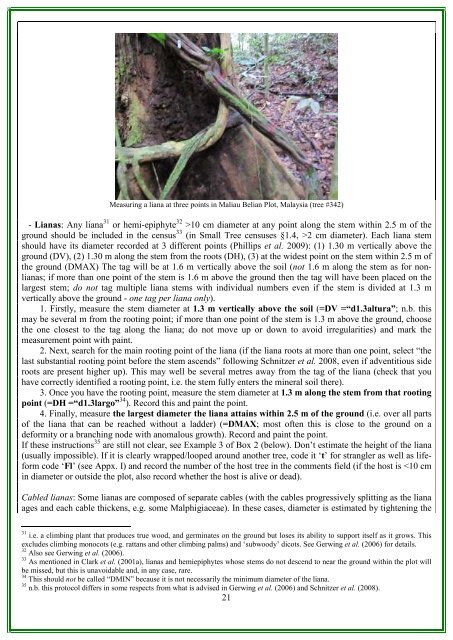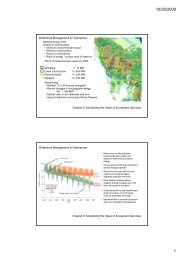RAINFOR GEM Intensive Plots Manual (pdf) - University of Oxford
RAINFOR GEM Intensive Plots Manual (pdf) - University of Oxford
RAINFOR GEM Intensive Plots Manual (pdf) - University of Oxford
- No tags were found...
Create successful ePaper yourself
Turn your PDF publications into a flip-book with our unique Google optimized e-Paper software.
Measuring a liana at three points in Maliau Belian Plot, Malaysia (tree #342)- Lianas: Any liana 31 or hemi-epiphyte 32 >10 cm diameter at any point along the stem within 2.5 m <strong>of</strong> theground should be included in the census 33 (in Small Tree censuses §1.4, >2 cm diameter). Each liana stemshould have its diameter recorded at 3 different points (Phillips et al. 2009): (1) 1.30 m vertically above theground (DV), (2) 1.30 m along the stem from the roots (DH), (3) at the widest point on the stem within 2.5 m <strong>of</strong>the ground (DMAX) The tag will be at 1.6 m vertically above the soil (not 1.6 m along the stem as for nonlianas;if more than one point <strong>of</strong> the stem is 1.6 m above the ground then the tag will have been placed on thelargest stem; do not tag multiple liana stems with individual numbers even if the stem is divided at 1.3 mvertically above the ground - one tag per liana only).1. Firstly, measure the stem diameter at 1.3 m vertically above the soil (=DV =“d1.3altura”; n.b. thismay be several m from the rooting point; if more than one point <strong>of</strong> the stem is 1.3 m above the ground, choosethe one closest to the tag along the liana; do not move up or down to avoid irregularities) and mark themeasurement point with paint.2. Next, search for the main rooting point <strong>of</strong> the liana (if the liana roots at more than one point, select “thelast substantial rooting point before the stem ascends” following Schnitzer et al. 2008, even if adventitious sideroots are present higher up). This may well be several metres away from the tag <strong>of</strong> the liana (check that youhave correctly identified a rooting point, i.e. the stem fully enters the mineral soil there).3. Once you have the rooting point, measure the stem diameter at 1.3 m along the stem from that rootingpoint (=DH =“d1.3largo” 34 ). Record this and paint the point.4. Finally, measure the largest diameter the liana attains within 2.5 m <strong>of</strong> the ground (i.e. over all parts<strong>of</strong> the liana that can be reached without a ladder) (=DMAX; most <strong>of</strong>ten this is close to the ground on adeformity or a branching node with anomalous growth). Record and paint the point.If these instructions 35 are still not clear, see Example 3 <strong>of</strong> Box 2 (below). Don’t estimate the height <strong>of</strong> the liana(usually impossible). If it is clearly wrapped/looped around another tree, code it ‘t’ for strangler as well as lifeformcode ‘Fl’ (see Appx. I) and record the number <strong>of</strong> the host tree in the comments field (if the host is





